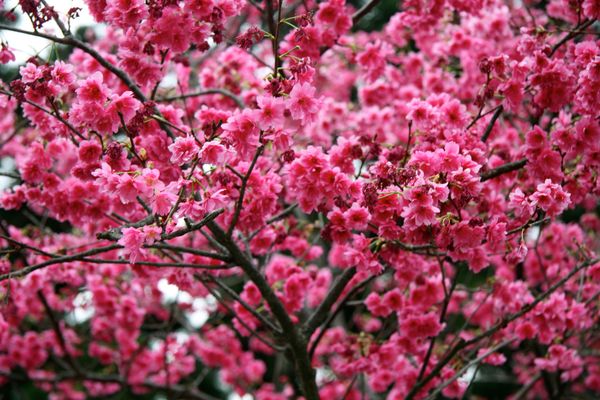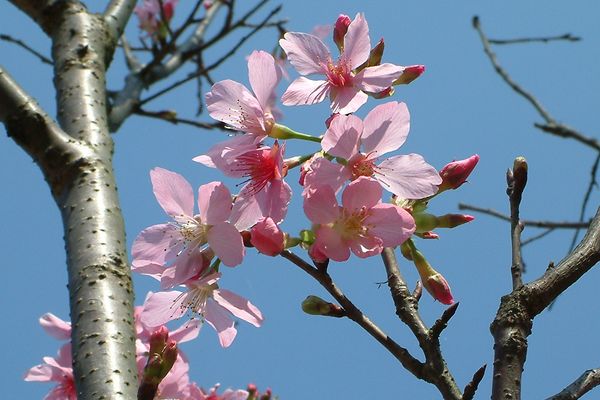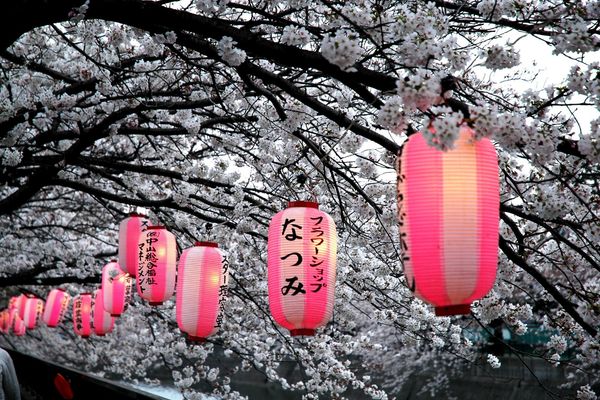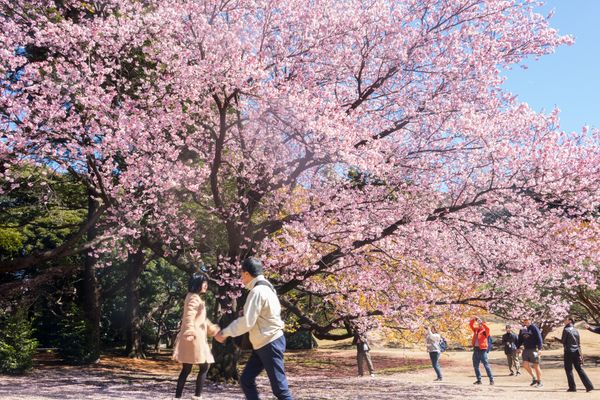When and where to see cherry-blossom in Japan
by Suzie
Every Spring, Japan celebrates the delicate pink and white blossom that bursts open on the flowering trees, and no-one visiting between February and May can fail to be caught up in the magic. Here’s our guide to staying in the pink during Japan’s annual blossom festival.

What’s it all about?
The ancient custom of ‘hanami’, or ‘flower viewing’, originally celebrated the ume (plum) blossom, but the cherry quickly stole the limelight and the springtime festivals have focused on sakura (cherry blossom) for over 1000 years. Hundreds of sakura cultivars grow throughout Japan, with flowers ranging in colour from white with just a hint of blush, to voluptuous fuchsia clusters, to the familiar, ballet-pink blooms with bold magenta cores.
During the season, groups of friends and family gather beneath the trees to have picnics by day and parties at night when the branches are illuminated with fairy lights. The night-time, cherry-centred yozakura parties can be pretty rowdy, but traditional ‘umemi’ or ‘plum-viewing’ parties are still held in places if you like a more sedate vibe.

Why is it such a big deal?
The blossom, which bursts so dramatically into being and then fades so quickly, has become synonymous with Buddhist concepts of mindfulness and being in the present. The flowers signify the circle of life, death and renewal, and exemplify the Japanese concept of ‘mono no aware’ – ‘the empathy of things’ which speaks of a wistful recognition of the transience of life. They are a reminder to, um, ‘carpe diem’. Deep stuff!
These bright heralds of spring are also a sign that the worst of the winter weather has passed. They welcome new beginnings, signifying fertility and hope for the growing crops, and it’s not surprising that sakura season coincides with the beginning of the Japanese academic and financial years.

When can we see it?
The season moves from south to north, starting around early February on Okinawa and finishing in May on Hokkaido. The exact dates are forecast in detail each year and, as the blossom only lasts a couple of weeks in each location, being in the right place at the right time is vital. The main 2018 season is estimated to be on the earlyish side of average, beginning in earnest on Kyushu on March 21st, with the best of the blooms on show across the country from late March to mid-April.
Where are the best spots?
Wherever you are in Japan during spring there will be blossom, so you won’t miss out! However, the debate about the best places in Japan to see the spectacle rages on, and an official list identifies prime spots in each prefecture. We’ve broken it down and selected a few favourites.
Early bird – The earliest flowers bloom in early February on the subtropical Okinawa archipelago, about 400 miles south of mainland Japan. Take a romantic walk through a tunnel of cherry trees at Nakijin Castle, lit-up at night by lanterns that mark out the path.
Last ‘sakura snow’ – Late spring visitors can join the celebrations on Hokkaido where the last blossom doesn’t fall, or ‘snow’, until May. Stay in Sapporo and enjoy the region’s famous seafood with a picnic in Maruyama Park under the cherry-tree avenue leading to Hokkaido Shrine.
Biggest – The famous Issingyo ‘Big Cherry’ in Kumamoto Prefecture is over 400 years old and stands an impressive 14 metres tall. This grand specimen transforms into a giant candyfloss-like cloud of pink from the end of March to mid-April, contrasting against the bright-yellow oil-seed below for stunning Instagram-worthy snaps.
Worth the hike – From Osaka or Kyoto, you can easily take a day trip to Mount Yoshino where hundreds of different cherry trees spill, waterfall-like, down the mountainside. Enjoy locally-made cherry mochi en route, and stay at the Hoshinoya, Kyoto where you can enjoy the stunning blossom displays in secluded riverside surroundings after an energetic day’s hiking.
Romantic – Treat yourself to a stay at a relaxing ryokan-style hotel in Hakone at the chic Gora Kadan or Aura Tachibana, which both have stunning views over the forested landscape. Explore the many bloom-filled parks, and get that iconic view of Mount Fuji through the blossom from the Five Lakes region.
Timewarp - See the spring countryside in old-school style at the Oigawa Railway in Shizuoka Prefecture. Take a mainline train from Tokyo, grab a seasonal bento from the local station and hop aboard to soak up the charm of seeing the cherry blossom from a steam train.
Big city – Tokyo really turns hanami up to 11! Enjoy the Nakameguro Cherry Blossom Illuminations along the riverside as the bubbles of the sakura-pink sparkling wine go to your head. If you don’t mind the crowds, head for Uena Park and soak up the festive atmosphere, or find a bit more peace and quiet at Asukayama Park which boasts a family-friendly monorail and play area among the blossom trees.
These recommendations are just the tip of the iceberg, as there are so many other beautiful places to see the blossom: Kanazawa castle, Takayama Spring Festival, Shikoku… too many to list! Ask our Destination Specialists for their personal favourites.

Hanami like a local
To enjoy the best of blossom season in Japan, you’ll want to book early. This is one of the most popular times to travel to Japan, so get your itinerary in place asap and be there to share the splendour.
Hanami picnics can be all-day affairs, and it pays to be prepared. You'll need a rug to sit on, and warm clothes, as spring evenings can still be chilly. Take whatever provisions float your boat, but for an authentic experience you could include a special hanami bento box filled with delicate bite-sized snacks to nibble between sips of sake. Satisfy your sweet tooth with traditional green, white and pink dango dumplings, and don’t forget a flask of something warming and cups to drink it from.
Caught the blossom bug?
Cherry-blossom season may be relatively short, but if it has fired your imagination for more there are further celebrations of nature in Japan throughout the year.
Umemi – Before the cherry blossoms arrive, the plum, or ume, trees bloom with delicate white blossom which can be seen from early February. Umemi festivals are generally quieter affairs than their rowdy cherry sisters, where you can drink umeshu (plum wine) and snack on pickled plums as you wish each other good fortune for the year ahead.
Oshima Camellia festival – This two-month long festival celebrates the blossom of tsubaki (Camellia). It takes place between January and March each year on Izu Oshima, the ‘Isle of Camellias’, a small island 2-hours from Tokyo by boat. The camellia blooms are stunning and there’s local folk art and music to get involved with too.
Peach Blossom Festivals – In Yamanashi Prefecture, the peach blossom gets almost as much attention as the cherry, and rightly so. There are three main festivals during April which celebrate these vivid pink flowers, but the most picture-perfect has to be in Nirasaki City with Mt. Yatsugatake in the background.
Mt Katsuragi Azalea Festival - Bigger and bolder than the delicate cherry blossom, the azaleas that bloom on Mt Katsuragi cover the mountainside in a blanket of deep, velvety pink during May. Hike up to the summit, breathe deep and enjoy the view.
Sapporo Lilac Festival - For northern Hokkaido, where the cold weather lasts the longest, the lilac festival marks the much-awaited return of summer. Celebrated in late May, this joyful festival is a chance to picnic in the sunshine enjoying the intoxicating scent of the lilacs.
Momijigari - When the seasons begin to turn towards winter again, the autumnal custom of momijigari, or ‘leaf peeping’ bookends the year’s celebration of trees. The maple trees put on a stunning display throughout the Japanese countryside, in every shade from deepest crimson to palest gold with flame and scarlet in between.
by Suzie on 14th February 2018